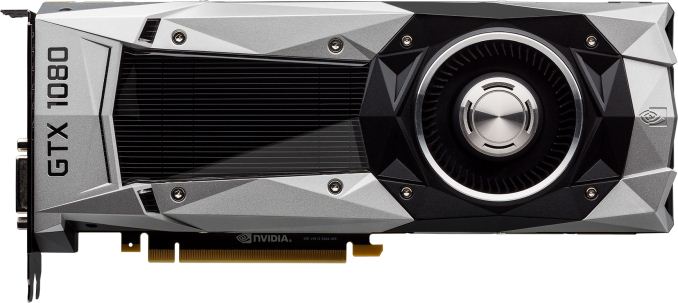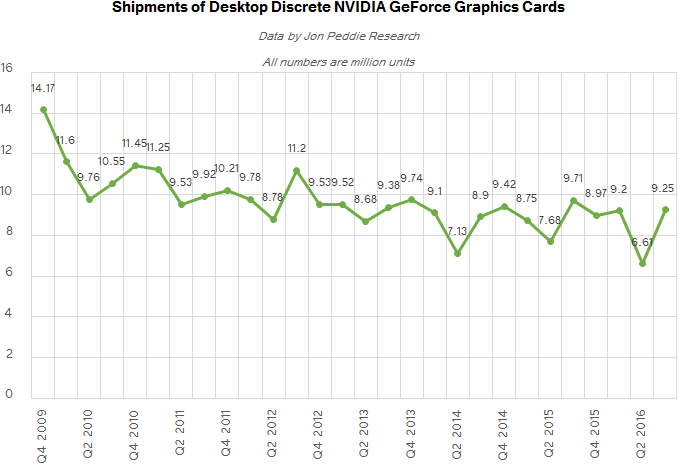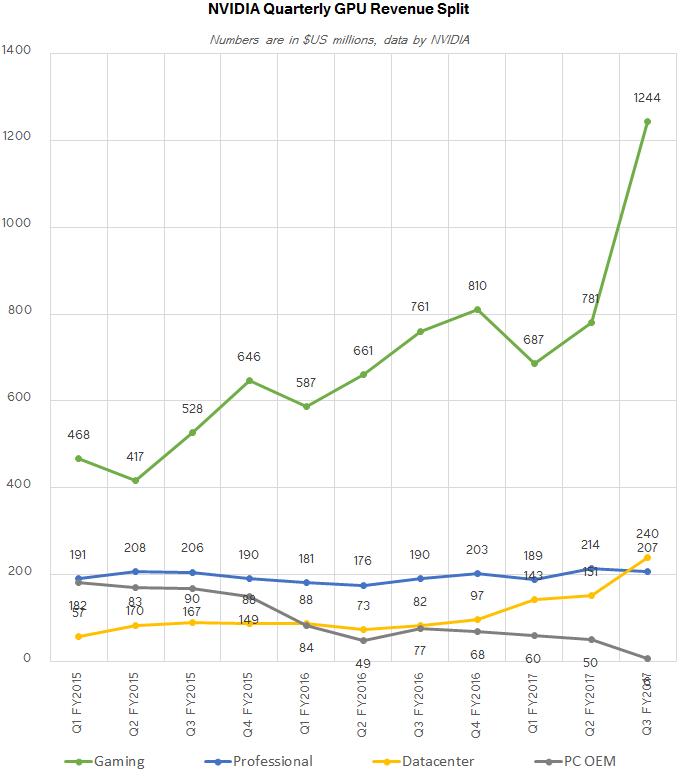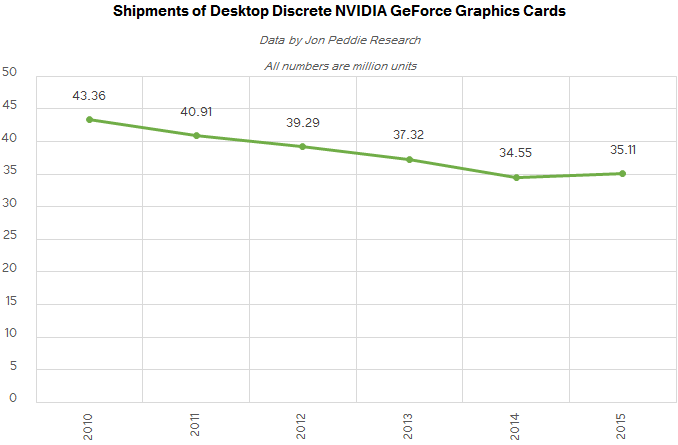Discrete Desktop GPU Market Trends Q3 2016: GPU Shipments Hit Two-Year High
by Anton Shilov on November 28, 2016 9:00 AM ESTNVIDIA: Record Sales of Gaming GPUs
Jon Peddie Research reports that NVIDIA shipped approximately 9.25 million desktop GPUs (up 39.8% QoQ) and increased its notebook GPU shipments by 38.7% sequentially in calendar Q3. NVIDIA does not officially disclose the number of graphics processors it sells, but the company’s revenue for gaming-grade GPUs skyrocketed to $1.244 billion in its Q3 FY2017 (ended October 30, 2016), so it is logical to assume that shipments of its graphics chips (both for desktops and notebooks) were very strong in the calendar third quarter as well.
“Gaming revenue crossed the $1 billion mark and increased 63% year-on-year to a record $1.24 billion, fueled by our Pascal-based GPUs,” said Colette M. Kress, CFO of NVIDIA, during the company’s earnings conference call. “Demand was strong in every geographic region across desktop and notebook, and across the full gaming audience, from GTX 1050 to the TITAN X.”
NVIDIA itself attributes its success in the third quarter to sales of its Pascal-based products — the GeForce GTX 1060, 1070 and 1080 as well as their mobile brethren. Since such boards start at $199 and their ASP should be considerably higher than that, it is not surprising that NVIDIA earned a lot despite a decrease in unit sales compared to Q3 in 2015. Unfortunately, we do not know exact rankings of AMD and NVIDIA in the enthusiast part of the market in terms of units, but it looks like the green company commands the lion’s share of this lucrative segment in terms of both units and dollars. Moreover, this situation is going to last for some time before AMD introduces its next-generation Greenland/Vega GPUs.
For the three-quarters so far in 2016, NVIDIA has sold approximately 25 million of desktop discrete GPUs. This is ~4% lower than in the first three quarters of 2015 (around 26 million). Nonetheless, despite slightly lower unit sales, the company is thriving financially due to higher ASPs. Moreover, NVIDIA’s management implies that demand for its desktop GPUs is still very high and sales of graphics cards may increase in Q4 as a result of improved yields and/or increased allocation at TSMC. If this happens, the company could sell around 35 million desktop GPUs in total this year, the same amount as in 2015.
“In terms of Pascal, we are still ramping,” said Jen-Hsun Huang, CEO of NVIDIA. “Production is fully ramped in the sense that all of our products are [certified and qualified with OEMs], they are on the market. However, demand is still high. So, we are going to continue to work hard, and our manufacturing partner TSMC is doing a great job for us.”














53 Comments
View All Comments
Atique786 - Friday, October 1, 2021 - link
This is a very informative and interesting article. I have enjoyed reading your post and have come to the conclusion that you are a professional writer.https://realrelaxmassagechairreview.com/
<a href="https://realrelaxmassagechairreview.com/">... Relax Massage Chairs</a>
<a href="https://realrelaxmassagechairreview.com/real-relax... Relax Massage Chair Review</a>
<a href="https://realrelaxmassagechairreview.com/real-relax... Relax 2020 Massage Chair</a>
Atique786 - Friday, October 1, 2021 - link
This is a very informative and interesting article. I have enjoyed reading your post and have come to the conclusion that you are a professional writer.https://realrelaxmassagechairreview.com/
<a href="https://realrelaxmassagechairreview.com/">... Relax Massage Chairs</a>
<a href="https://realrelaxmassagechairreview.com/real-relax... Relax Massage Chair Review</a>
<a href="https://realrelaxmassagechairreview.com/real-relax... Relax 2020 Massage Chair</a>
tipoo - Monday, November 28, 2016 - link
This is an important counterpoint to the "PC shipments are falling" doom and gloom. PC shipments are falling because a 5 year old 2500K can still run modern games if the GPU allows. But PC /gaming components/ are on the upswing, so it's still a great time to be a PC gamer. Complete system sales are tertiary.BrokenCrayons - Monday, November 28, 2016 - link
This sums up the state of the declining computer sales nicely. While CPU performance and platform features (minor nod to USB) haven't pushed the performance envelope enough to matter AND software isn't demanding more, the GPU industry is driven by pent-up demand for a die shrink and widespread increases in screen resolution.Threska - Sunday, December 4, 2016 - link
Well the killer uses for GPUs are going to be VR and machine learning.0ldman79 - Monday, November 28, 2016 - link
That's not necessarily a problem.We need tech to settle a bit. That might actually increase overall ownership and total market penetration. Having to upgrade the machine every two years just to keep up has kept a lot of people out of the market for anything but the cheapo computer.
Strunf - Thursday, December 8, 2016 - link
People didn't upgrade the machines every two years to keep up, CPU wise we have reached a good enough CPU for the average user like 10 years ago, people who upgrade every 2 years are enthusiasts and they will keep to do so, the ones who stopped upgrading are the ones that have a already good enough PC... or the vast majority of PC users and companies.There isn't really a problem, PC shipment will keep going down cause a PC has nowadays a very long useful life and cause of other technologies, tablets already replaced the PC on many households... my guess in a few years Gamers will represent the vast majority of the PC users and until then desktop PC sales will keep going down, and even then there are new technologies that allow to play PC Games over the network without even having a PC.
stephenbrooks - Tuesday, November 29, 2016 - link
Another thing to bear in mind with these graphs is the comparative improvement of integrated graphics over the time frame. It must be eating the low-end of discrete GPUs by this point.Samus - Tuesday, November 29, 2016 - link
The problem isn't just a 5 year old 2500K is adequate for most common games, but many other tasks, especially simple content consumption, are clearly delegated to other devices most prominently smart phones and tablets.Unless you desire a PC for gaming, or you are a business owner that is sticking to the legacy operations schema (and not modernizing your IT infrastructure) then desktop PC's don't offer any clear compelling advantage over laptops and mobile devices.
Meteor2 - Wednesday, November 30, 2016 - link
Well, AIOs look nice, and are nice to use. Whether they're actually 'desktops', as they use laptop components, is another question.